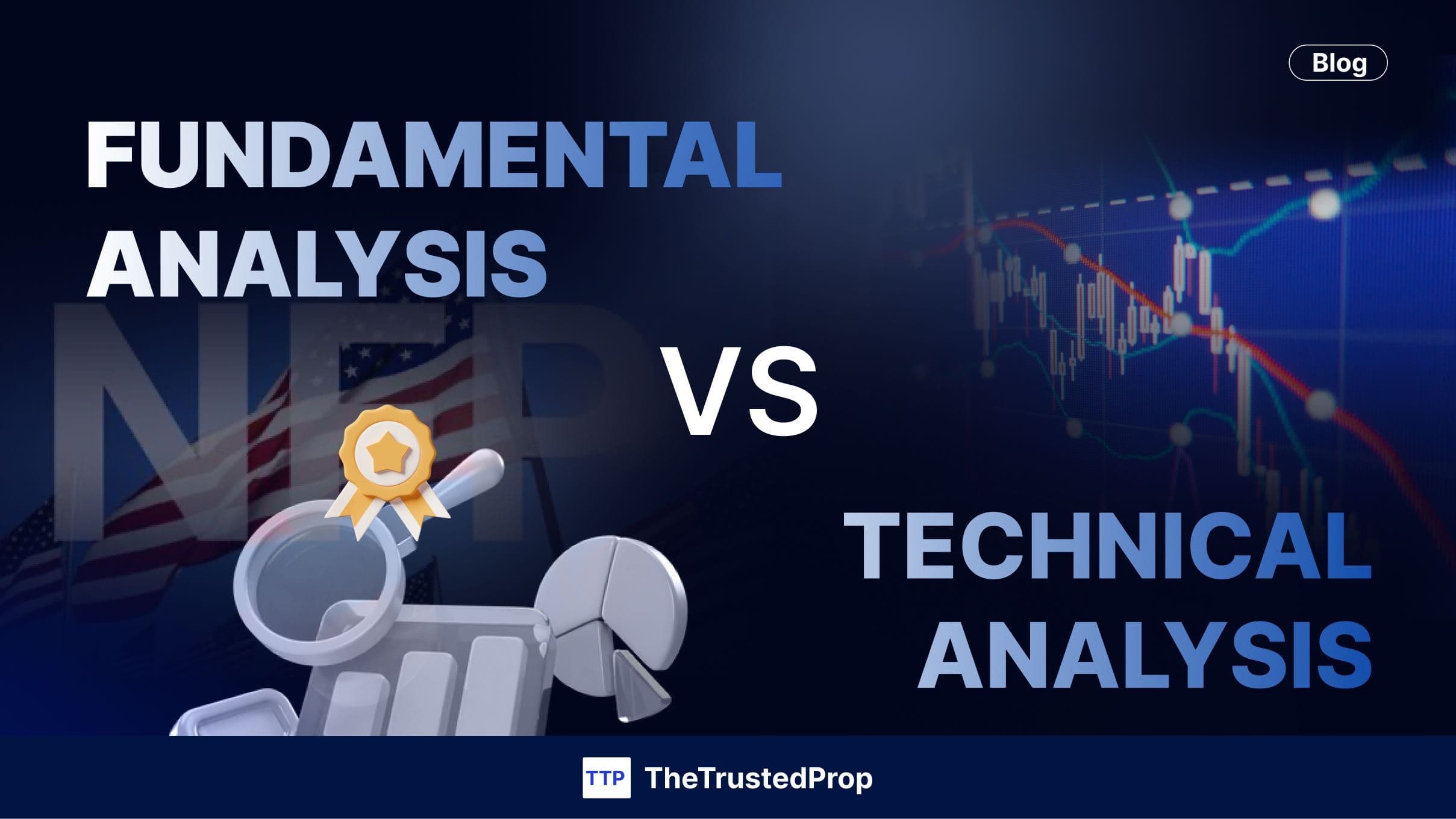Fundamental Analysis VS Technical Analysis: Key differences between them

Fundamental Analysis VS Technical Analysis: Key differences between them
2/26/2025
In the trading industry, traders use two types of analysis strategies before operating. Both methods have different methodologies and strengths, catering to various kinds of market players.
It is possible for the differences between both strategies to help traders and investors in creating an equitable approach to the stock market.
Let’s analyze.
What is Fundamental Analysis?
With this method, traders analyze the value of a company’s security by evaluating financial and economic data. Fundamental methods help investors on items such as earnings, revenue growth prospects, or stock that is undervalued or overpriced.
Key Elements of Fundamental Analysis:
Financial Statements:
In Forex Markets, Financial Statements play one of the most important roles in where the price trend will go as traders can see the reports of each company and even government interest in various sectors and commodities. With these financial statements, traders can also understand Cash flow statements, with which traders can speculate the movement of funds for a longer time.
Economic Indicators:
GDP growth, interest rates, and inflation are the most important economic indicators. GDP growth is an indicator of economic growth, where increased growth represents strength and decreased growth represents a slowdown. Interest rates, established by central banks, determine borrowing and investment; low interest rates stimulate spending, while high interest rates curb inflation. Inflation monitors price growth. It’s impact on purchasing power and monetary policy.
Company Valuation:
Company Valuation: The company valuation is founded on financial ratios like the Price-to-Earnings (P/E) ratio and earnings per share (EPS) to quantify stock value. The P/E ratio is the proportion of a firm's stock price to its earnings, indicating whether it is overvalued or undervalued relative to its industry counterparts. EPS calculates profitability by dividing net income into outstanding shares and represents the amount of profit made per share by the company. A greater EPS means good financial performance, and hence, investors are interested in purchasing the stock. Both these figures assist in evaluating the financial health and investment value of a company.
Long-term focus:
A long-term approach is suitable for investors aiming for stable returns and wealth growth over the years. This method focused on robust fundamentals, gradual growth, and compounding gains, minimizing the effects of short-term market movements. Long-term investors focus on assets with regular performance, such as blue-chip shares, bonds, and index funds, taking advantage of economic cycles and investing again or anew. Calm and disciplined investment reduces risks while generating maximum returns, making it the most sought-after method for financial security and wealth preservation.
What is Technical Analysis?
Technical trading analysis is used to analyze past price actions to find future trends. Technical analysis of the stock market is utilized to identify patterns, understand market sentiment, and determine entry or exit points. Technical analysis is used in several assets, ex: stocks, forex, commodities, and cryptocurrencies.
Important concepts of Technical Analysis:
Price Trends:
Price action is an indicator of market direction and changes in three general types: uptrend, downtrend, and sideways trend. An uptrend exists when prices rise persistently, creating higher highs and higher lows, representing solid buying pressure and confidence by investors. A downtrend is just the opposite, with prices falling, creating lower highs and lower lows, which indicate selling pressure and weakness in the market. A trend sideways occurs when prices oscillate between two levels without any established direction as a sign of market indecision. Knowledge about these trends informs entry and exit strategies, risk control, and sentiment in the market.
Support and Resistance Levels:
Resistance and support levels are prices at which pressure to buy or sell determines direction. Support is the price level where demand is strong enough to hold the price up, typically forcing a price bounce as buyers move in. Resistance is the reverse, where selling pressure keeps the price from rising further, forcing a reversal or consolidation. Such levels serve as mental barriers, leading the traders to establish entry and exit points, stop-loss, and profit points. Breaks above resistance or below support could be indicative of trend continuation failed efforts to consolidate these levels as robust zones of the market.
Technical Indicators:
Technical indicators, such as Moving Averages (MA), Relative Strength Index (RSI), and MACD, are used to evaluate market trends and momentum. MAs smooth price data to indicate trend direction, with 50-day and 200-day MAs calling attention to bullish or bearish signals. RSI measures price momentum on a scale of 0-100, indicating overbought at levels above 70 and oversold at levels below 30. MACD gauges the strength of a trend by comparing short- and long-term MAs, and crossovers indicate potential buying or selling opportunities.
Short-Term Focus:
A short-term orientation is appropriate for day trading and swing trading, where investors take advantage of rapid price fluctuations. Day traders buy and sell within a day, using technical analysis, while swing traders keep trades for days or weeks to ride short-term trends. This approach requires rapid decision-making, good risk management, and efficient application of trading indicators to handle market volatility.
Comparison between Fundamental and Technical Analysis
| Aspect | Fundamental Analysis | Technical Analysis |
| Focus | Company’s value and financial health | Market trends and price patterns |
| Key tools | Economic report, financial statements | Trend analysis, charts |
| Time Horizon | Long-term | Short-term |
| Decision Basis | Data on economics and finance | Illustrates price movements |
| For use | Investors | Traders |
Which Analysis Method Should You Use?
For Long-Term Investing:
Fundamental analysis and Technical analysis are coaching faster. Fundamental analysis is a method piloted to finance vigilance investors so they can discern the actual worth of a business. On the other hand, technical analysis is a method to track the trends of price and the level of the market. Therefore, an investor is free to choose one strategy, or the other, or use both to maximize success according to their preferences.
For Active Trading:
Active trading can be easily improved with the help of technical analysis by having a brief and focused period, which will boost the traders' ability to exploit market fluctuations. It is based on the charts, patterns, and technical indicators such as moving averages, RSI, and MACD used for the search of the forecast of the price trends and determination of the proper timing for the market entry and exit.
Hybrid Approach:
A hybrid strategy that blends the benefits of technical and fundamental analysis is developed; this approach is noted to be beneficial for both the traders and the investors. The fundamental analysis assists in the discovery of robust assets with long-term growth prospects; in the meantime, the technical analysis targets the perfect entry and exit prices based on market trends and price fluctuations.
Conclusion
Fundamental analysis and Technical analysis are both important in trading. Fundamental analysis assists investors in perceiving the intrinsic worth of a company, while technical analysis lists information about market and price ups and downs. A person can rely on one approach or both based on their investment goals, and the combination may ensure the maximum benefits.
No matter if you are an active trader or a passive investor, education in such analytical tools is the necessary basis for making financial decisions that will be judgments you can be proud of and others can benefit from.
You may also like
FundedElite Challenge Accounts: Our Honest 2025 Review
.jpeg&w=1920&q=75)
How to Get Started with FTMO: Full Guide for Indian Traders in 2025

My Forex Funds Relaunch 2026: Is It Coming Back Officially?

iFunds Prop Firm Payout Rules, Profit Split & Scaling 2025

How to Pass the FTMO Challenge FAST: Full Guide for Indian Traders

FORFX Payouts, Profit Split & Withdrawal Rules (2025 Guide)

Top Prop Firm Trading Competitions of 2026: Win Free Accounts

No FAQs are available for this topic yet.

.jpeg&w=3840&q=75)

























